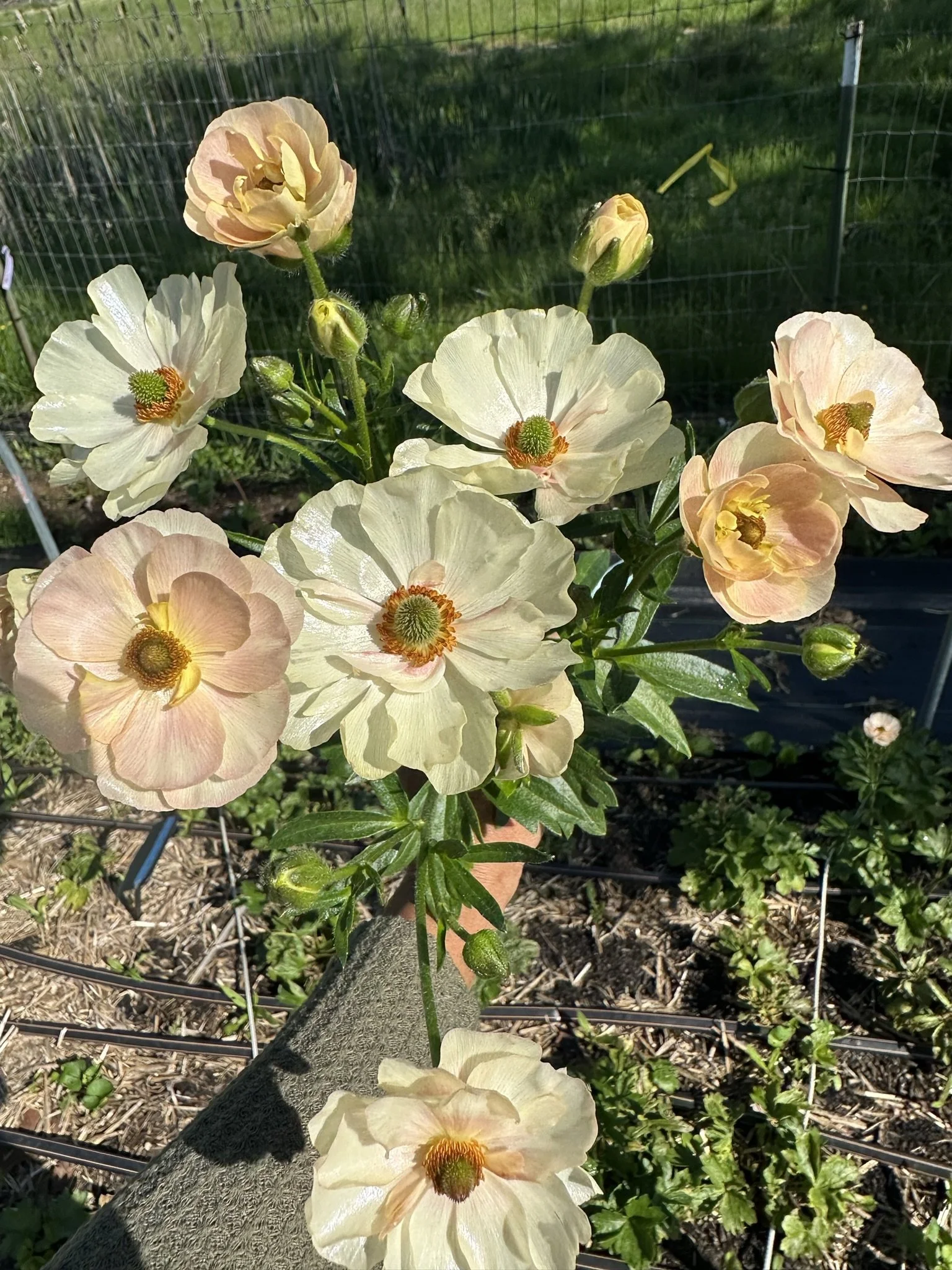 Image 1 of 2
Image 1 of 2

 Image 2 of 2
Image 2 of 2



Butterfly Ranunculus Keramos
Pack size : 5 corms
Fall Shipping (late September - late October)
Butterfly Ranunculus ‘Keramos’
Keramos opens in a delicate shade of the palest blush — so soft it’s almost ivory, with just the faintest whisper of pink. The semi-double blooms shimmer with a pearly sheen, dancing on slender, branching stems that give them an effortless, airy charm. Ideal for cutting, but just as graceful in the garden, it brings a sense of lightness and quiet elegance to spring displays. Subtle, refined, and beautifully understated.
How to Plant & Grow Butterfly Ranunculus
Quick Planting Guide
Planting time: Fall in mild climates (Zones 7–10), or very early spring after frost in colder climates
Soil: Loose, fertile, well-draining
Depth & spacing: 2–3" deep, 6–9" apart
Light: Full sun (with afternoon shade in hot regions)
Bloom: 10–12 weeks after planting (fall planting = late winter–spring blooms; spring planting = late spring–early summer blooms)
Step-by-Step Planting Instructions
1. Prepare the corms
Butterfly ranunculus grow from small, claw-shaped corms.
Soak corms in cool water for 3–4 hours before planting (do not exceed 6 hours).
The “claw” side points down when planting. If unsure, lay sideways.
2. Pre-sprouting (recommended for best success)
Pre-sprouting gives stronger roots and more uniform flowering.
After soaking, place corms in a shallow tray with slightly damp vermiculite, peat moss, or potting mix.
Store in a cool, dark spot (around 40–50°F / 4–10°C) for 1–2 weeks.
Once white rootlets appear, transplant into beds or pots.
3. Prepare the planting site
Choose a sunny spot with excellent drainage — soggy soil will rot corms.
Loosen soil 8" deep and mix in compost for fertility and sand/grit if soil is heavy.
Raised beds or containers are excellent options.
4. Plant the corms
Plant 2–3" deep, 6–9" apart.
Water well after planting.
In cooler climates, protect with frost cloth until plants establish.
5. Growing on & care
Watering: Keep soil evenly moist, but never waterlogged.
Feeding: Once shoots emerge, feed every 2–3 weeks with a balanced liquid fertilizer or organic flower feed.
Mulching: A thin mulch layer helps regulate moisture and temperature.
6. Bloom time & harvest
Butterfly ranunculus typically flower 10–12 weeks after planting.
Stems are ready to harvest when buds are soft and petals just begin to unfurl.
Regular cutting encourages new blooms.
Vase life is 10–12 days, sometimes longer.
Tips for Success
Stagger plantings every 2 weeks for a longer bloom season.
Protect young shoots from slugs, snails, and late frost.
Butterfly ranunculus are prized cut flowers with strong stems, shimmering petals, and exceptional vase life — a true florist’s favorite.
Pairs beautifully with anemones, tulips, and other spring bulbs
Pack size : 5 corms
Fall Shipping (late September - late October)
Butterfly Ranunculus ‘Keramos’
Keramos opens in a delicate shade of the palest blush — so soft it’s almost ivory, with just the faintest whisper of pink. The semi-double blooms shimmer with a pearly sheen, dancing on slender, branching stems that give them an effortless, airy charm. Ideal for cutting, but just as graceful in the garden, it brings a sense of lightness and quiet elegance to spring displays. Subtle, refined, and beautifully understated.
How to Plant & Grow Butterfly Ranunculus
Quick Planting Guide
Planting time: Fall in mild climates (Zones 7–10), or very early spring after frost in colder climates
Soil: Loose, fertile, well-draining
Depth & spacing: 2–3" deep, 6–9" apart
Light: Full sun (with afternoon shade in hot regions)
Bloom: 10–12 weeks after planting (fall planting = late winter–spring blooms; spring planting = late spring–early summer blooms)
Step-by-Step Planting Instructions
1. Prepare the corms
Butterfly ranunculus grow from small, claw-shaped corms.
Soak corms in cool water for 3–4 hours before planting (do not exceed 6 hours).
The “claw” side points down when planting. If unsure, lay sideways.
2. Pre-sprouting (recommended for best success)
Pre-sprouting gives stronger roots and more uniform flowering.
After soaking, place corms in a shallow tray with slightly damp vermiculite, peat moss, or potting mix.
Store in a cool, dark spot (around 40–50°F / 4–10°C) for 1–2 weeks.
Once white rootlets appear, transplant into beds or pots.
3. Prepare the planting site
Choose a sunny spot with excellent drainage — soggy soil will rot corms.
Loosen soil 8" deep and mix in compost for fertility and sand/grit if soil is heavy.
Raised beds or containers are excellent options.
4. Plant the corms
Plant 2–3" deep, 6–9" apart.
Water well after planting.
In cooler climates, protect with frost cloth until plants establish.
5. Growing on & care
Watering: Keep soil evenly moist, but never waterlogged.
Feeding: Once shoots emerge, feed every 2–3 weeks with a balanced liquid fertilizer or organic flower feed.
Mulching: A thin mulch layer helps regulate moisture and temperature.
6. Bloom time & harvest
Butterfly ranunculus typically flower 10–12 weeks after planting.
Stems are ready to harvest when buds are soft and petals just begin to unfurl.
Regular cutting encourages new blooms.
Vase life is 10–12 days, sometimes longer.
Tips for Success
Stagger plantings every 2 weeks for a longer bloom season.
Protect young shoots from slugs, snails, and late frost.
Butterfly ranunculus are prized cut flowers with strong stems, shimmering petals, and exceptional vase life — a true florist’s favorite.
Pairs beautifully with anemones, tulips, and other spring bulbs